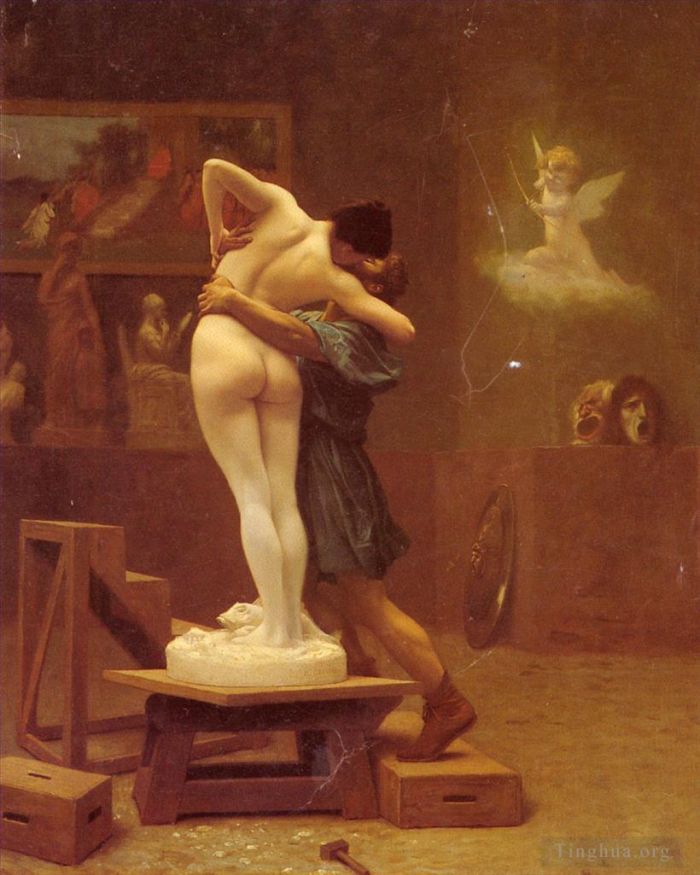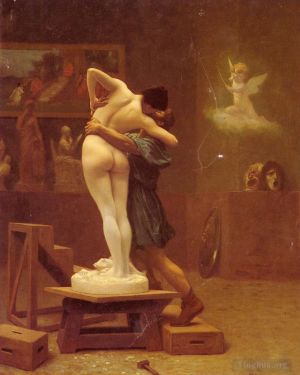Pygmalion And Galatea
Jean-Leon Gerome
- Price: Price on Request
- Art Type: Oil Painting
- Size:
- English Comments: 0
- International Comments: 0
- Creating Date:
- Introduction and Works of Jean-Leon Gerome >>
Work Overview
- Pygmalion and Galatea
Artist Jean-Léon Gérôme
Year 1890
Medium Oil on canvas
Dimensions 89 cm × 69 cm (35 in × 27 in)
Location Metropolitan Museum of Art, New York City
Pygmalion and Galatea (French: Pygmalion et Galatée) is an 1890 painting by the French artist Jean-Léon Gérôme.[1] The motif is taken from Ovid's Metamorphoses, and depicts how the sculptor Pygmalion kisses his ivory statue Galatea, after the goddess Venus has brought her to life.
Jean-Léon Gérôme painted Pygmalion and Galatea in the summer of 1890. In 1891 he made a marble sculpture of the same subject, possibly based on a plaster version also used as model for the painting. He made several alternative versions of the painting, each presenting the subject from a different angle.
The most famous version, where Galatea is seen from behind, was bought by Boussod, Valadon & Cie on 22 March 1892. It was sold several times until it was donated to the Metropolitan Museum of Art by Louis C. Raegner in 1927. The other versions are in private collections or lost.
Between 1890 and 1892, Gérôme made both painted and sculpted variations on the theme of Pygmalion and Galatea, the tale recounted in Ovid’s Metamorphoses. All depict the moment when the sculpture of Galatea was brought to life by the goddess Venus, in fulfillment of Pygmalion’s wish for a wife as beautiful as the sculpture he created. This is one of three known versions in oil that are closely related to a polychrome marble sculpture, also fashioned by Gérôme (Hearst Castle, San Simeon, Calif.). In each of the paintings, the sculpture appears at a different angle, as though it was being viewed in the round.
- Copyright Statement:
All the reproduction of any forms about this work unauthorized by Singing Palette including images, texts and so on will be deemed to be violating the Copyright Laws.
To cite this webpage, please link back here.
- >> English Comments
- >> Chinese Comments
- >> French Comments
- >> German Comments
- >>Report
- Decoration
- La Femme Au Voile
- Bacchante Et LAmour
- Dancing Girl with an Apple
- The Gladiators
- Selene
- Sarah Bernhardt
- Mirmillo
- Sorrow
- Corinth
- Retiarius
- Caesar Crossing the Rubicon
- Corinthe A Seated Female Nude
- Tanagra
- The Ballplayer
- The Harem Bath
- BashiBazouk and his Dog
- Drunken Bacchus and Cupid
- Portrait of a Lady cat167
- The Grief of the Pasha
- A Moorish Bath (Turkish Woman Bathing)
- Woman of Cairo at her Door
- Arnaut blowing Smoke at the Nose of his Dog
- The Call to Prayer
- Head of a Peasant of the Roman Campagna
- Markos Botsaris
- The Death of Caesar
- Dispute DArabes
- Souvenir DAcheres
- Bashi Bazouk singing
- Prayer in the Desert
- Veiled Circassian Lady
- Arab Girl with Waterpipe
- Portrait of a Lady
- Police Verso
- Portrait of a Cactus Collector
- Moorish Bath
- The Cock Fight
- The Negro Master of the Hounds
- Sketch for the Excursion of the Harem
- Napolean and his General Staff in Egypt
- Saber dance engraving
- Tiger on the Watch2
- The age of Augustus the Birth of Christ Greek Arabian
- Portrait of a Lady2
- Excursion of the Harem
- The Carpet Merchant
- Painting Breathes Life into Sculpture
- French 1824to 1904Une Journee Chaud Au Caire Devant2
- Solomons Wall Jerusalem
- Black BashiBazouk
- The Standard Bearer
- Portrait of a Young Boy
- Mufti Reading in His Prayer Stool
- Working in Marble
- A Cafe in Cairo
- Arnaut smoking
- Bathsheba
- The Carpet Merchant Jean Leon Gerome
- Prayer on the Housetops
- Socrates seeking Alcibiades in the House of Aspasia
- Night
- Lion dusk
- The Syrian Shepherd
- Egyptian Recruits crossing the Desert
- The Picador
- Madeleine Juliette Gerome et Ses Poupees
- Lion on rock
- Dante He Hath Seen Well
- Tiger on the Watch 3_2
- Harem Women Feeding Pigeons in a Courtyard
- Anacreon Bacchus and Cupid
- Louis XIV and Moliere
- Cave Canem
- Painting Breathes Life into Sculpture 1893
- Portrait of a Lady3
- Young Greeks at the Mosque
- Lion
- Sculpture Vitam Insufflat Pittura
- Portrait of Mlle Durand
- Cleopatra before Caesar
- Bathers by the Edge of a River
- Pifferari 2
- Diogenes
- Study of a Dog
- Le Jour Du Jugement Dernier
- Treading out the Grain in Egypt
- Quaerens Quem Devoret
- King Candaules
- Self Portrait
- Portrait of a Roman woman
- View of Paestum
- Portrait of Eduoard Delessert
- The Pyrrhic Dance
- The Dance of the Almeh
- The Reception of the Siamese Ambassadors at Fontainebleau
- The Arab and his Steed
- Leaving the Mosque
- The Duel After the Masquerade
- Pygmalion And Galatea
- Waiting for an Audience
- Pifferari cat 196
- Camels at the Fountain
- Napoleon and His General Staff Arabian
- Slave Market
- PersonnageLouis XIII
- Portrait of M Leblond
- The Memnon and Sesostris
- Bisharin Warrior
- Greek Interior sketch
- The Chess Players
- View of Cairo undated
- Arabs crossing the Desert
- A Street Scene in Cairo
- Love the Conqueror
- A Chat by the Fireside
- The Christian Martyrs Last Prayer
- Prayer in the House of an Arnaut Chief
- Pool in a Harem
- The Virgin the Infant Jesus and St John
- Achat DUne Esclave
- Pifferari
- Frederick the Great
- The Duc de La RochefoucauldDoudeauville
- An Arab Caravan outside a Fortified Town Egypt
- The Tulip Folly
- The Plague at Marseilles
- Anacreon 3
- Tiger on the Watch
- Slave Auction
- Interior of a Mosque 1870
- Sais and his Donkey
- Pelt Merchant of Cairo
- Heads of the Rebel Beys
- Egyptian Water Carrier
- BashiBazouk singing
- The Tombe of Hazrat Imam Hisain Allahis Salam
- Un Marchand Darmes Au Caire
- The Last Communion of St Gerome
- Moses on Mount Sinai
- The Muezzins call to prayer
- A Collaboration
- The Colossus of Memnon
- Cairene Horse Dealer
- SNAKE CHARMER
- Femme nue
- The Grey Cardinal
- A Japanese imploring a Divinity
- Harem in the Kiosk
- Prayer in the Mosque
- Pho Xai
- Study Age of Augustus Birth of Christ Greek Arabian
- Arnauts of Cairo at the Gate of BabelNasr Greek Arabian
- The Bacchante
- The Republic
- Summer Afternoon on a Lake
- Phryne before the Areopagus
- Prayer in the Mosque
- Michelangelo
- Whirling Dervishes
- Julius Caesar and Staff
- Recreation in a Russian Camp
- An Arab and his Dog
- View Of Cairo









 Singing Palette
Singing Palette